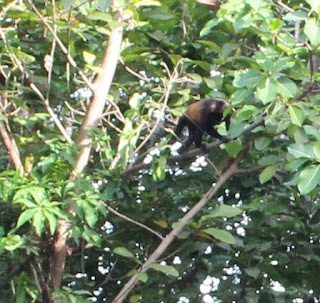After our day trip to the Costa Rican border, we spent Saturday traipsing up and down Vulcan Masaya, which was smoking pretty enthusiastically that morning, followed by stops in the Masaya Nuevo Mercado, and on to Granada for lunch and a look at the beautiful church in the town center.
Our next sojourn took us north to Matagalpa. Our destination was a restaurant/hotel/coffee estate called Selva Negra, or "Black Forest," yes, just like the pine forests in Germany. It seems a German family were so taken with this slice of their homeland that they bought the place and entered the coffee business, later expanding the operation to become a destination for both locals and tourists. They even offer a couple of German entrees on the restaurant menu. I had Wiener Schnitzel, and it was pretty dry. Tey had the sausages and pronounced them excellent. Near the dining area was a play space for children (happily empty) with several geese in residence. A big gander moseyed over and terrorized a foursome of German-speaking diners for a few minutes.
Also on offer was a tour of the coffee operation, but for day visitors, the price was a steep $20 each. So we opted to visit the little coffee museum in Matagalpa, which had lots of information on large posters, and a few artifacts, like a coffee bean de-pulper which removes the red fruit-like covering from the bean. The beans must be soaked and hulled and fermented, and dried slowly before roasting. Just south of Matagalpa city, we saw the drying phase in action, as workers raked the piles of beans over and over to make sure the bottom layers had their time in the sun and did not become moldy.
This region of Nicaragua is mountainous and cool. We enjoyed the scenery, as well as our German lunch in coffee country. We also learned that Nicaragua produces only about 2% of the world's coffee. But what coffee they have here is "cherce," to paraphrase Spencer Tracy.
Tey and I planned to visit Leon on the day before Thanksgiving, to collect her friend Tom who had traveled down with her from Mexico. We drove to Managua on Tuesday and visited the Plaza de la Revolución, and the Palacio de la Cultura. Tey was unimpressed with Managua, which is really such a large collection of barrios, with no cultural district to speak of. Managua could use a free map for tourists interested in gallery crawls and artists' studios, which must be all over the city.
Later, we headed to Ivan and Erlinda's house. We were chatting with Erlinda, and the subject of the 1972 earthquake came up. As Erlinda was speaking, our chairs began to vibrate and sway. Hello...
An earthquake! Not so big, really. About 4.2 on the Richter scale, it turned out. But it lasted about ten seconds, and was timed perfectly with our conversation!
We spent the night with Erlinda and family, and rose early to leave for Leon in the morning. The "new" road to Leon passes the large volcano Momotombo, which sits just north of Lake Managua. It was a clear morning, and the vulcan was smoking briskly.
In downtown Leon, a large effigy of a colorful woman with a top hat, enormous bosom and ruffled skirt had been erected next to the park in front of the cathedral. We learned that she is called "La Gigantona," and Tey did a bit of internet research to find our about her and her sidekick, El Enano Cabezon, "big-headed dwarf," a little chap with a big round head.
The kids below were drumming and dancing nearby, playing out the passion of the diminuitive Mestizo for the tall, busty European Spanish lady! Well, La Gigantona's leg man was taking a break, apparently.
Just as we were leaving Leon, we caught a glimpse of the volcano Telica, which had erupted within the past couple of days, and was smoking.
Photo credits: Tey, la Yucatana.



























